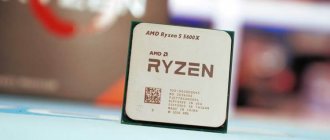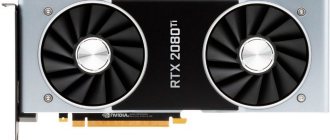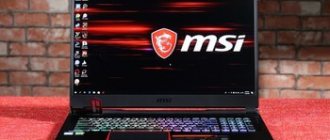| Place | Name | Characteristics in the rating |
| TOP 5 best video cards from AMD |
| 1 | PowerColor AMD Radeon RX 6900 XT Red Devil | The most powerful video card for gaming |
| 2 | ASUS DUAL Radeon RX 580 OC 8GB | The best AMD gaming card in the mid-budget segment |
| 3 | GIGABYTE Radeon RX 6700 XT | Balanced option for gaming |
| 4 | ASUS ROG Strix Radeon RX570 OC 8GB | People's card |
| 5 | Sapphire PULSE Radeon RX 550 4GB | Budget option for undemanding users |
Market leaders for video cards based on AMD chips
Not all video card manufacturers offer their customers options based on AMD solutions, but there are still enough of them to provide a decent choice. If we single out individual leaders, the best models are offered by the following companies:
ASUS
. A brand with a rich history, producing a full range of video cards, from simple budget cards for office PCs to its own professional-level gaming lines.
GIGABYTE
. A reliable manufacturer that knows how to unlock the potential of AMD GPUs and supply them with high-quality components to extend their service life.
Sapphire
. A Chinese company that is an exclusive partner of AMD, which allows it to be the first to introduce advanced technical solutions in its video cards.
PowerColor
. A brand that is gaining increasing popularity due to its excellent quality and reasonable pricing policy.
Rating of the TOP 10 best AMD video cards
| Place | Name | Price |
| TOP 5 best powerful AMD gaming video cards | ||
| 1 | Sapphire Nitro+ Radeon RX 5700 XT 1770MHz PCI-E 4.0 8192MB | Find out the price |
| 2 | ASRock Radeon RX 5700 XT 1650MHz PCI-E 4.0 8192MB | Find out the price |
| 3 | Sapphire Pulse Radeon RX 580 1366MHz PCI-E 3.0 8192MB | Find out the price |
| 4 | GIGABYTE Radeon RX 5600 XT 1460MHz PCI-E 4.0 6144MB | Find out the price |
| 5 | ASUS DUAL Radeon RX 5500 XT 1733Mhz PCI-E 4.0 8192Mb | Find out the price |
| TOP 5 best AMD video cards in price/quality ratio | ||
| 1 | Sapphire Pulse Radeon RX 550 1206Mhz PCI-E 3.0 4096Mb | Find out the price |
| 2 | Sapphire Pulse Radeon RX 5500 XT 1737Mhz PCI-E 4.0 4096Mb | Find out the price |
| 3 | ASUS ROG Radeon RX 570 1168MHz PCI-E 3.0 8192MB | Find out the price |
| 4 | MSI Radeon RX 5500 XT 1647Mhz PCI-E 4.0 8192Mb | Find out the price |
| 5 | Sapphire Pulse Radeon RX 570 1284Mhz PCI-E 3.0 8192Mb | Find out the price |
How to choose a video card with an AMD graphics chip?
When choosing video cards assembled on an AMD chip, you should definitely pay attention to the following points:
Memory type
. Many AMD video cards use GDDR5 memory, which is noticeably inferior in speed to the more modern GDDR6 format. The first option is quite suitable for a work PC, but for a gaming PC it is better to choose the second one.
Energy consumption
. Make sure that your computer's power supply has sufficient power and the necessary cables to connect additional power to the video card.
Cooling system
. A reliable card must be equipped with active cooling, and the PC case must provide proper air circulation, otherwise the video card may operate at elevated temperatures, which will affect its performance.
Motherboard compatibility
. A common problem with video cards based on AMD chips is the compatibility of their drivers with motherboards. Be sure to check support for your model on the manufacturer's official website.
The best AMD video cards in terms of price/quality ratio
Sapphire Pulse Radeon RX 550 1206Mhz PCI-E 3.0 4096Mb
This is a budget video card based on the AMD Polaris 12 GPU with efficient cooling and support for three-monitor systems.
Used as part of personal computers without a built-in video core. It demonstrates excellent 3D performance.
If we compare it with the Nvidia GeForce GT 1030. The graphics processor paired with 4 GB provides confident playability at medium-low graphics quality settings at resolutions up to 1920x1080.
Support for API DirectX 12 and OpenGL 4.5 is provided, which allows you to use all available graphics technologies and accelerate the decoding of content in high and ultra-high resolution.
The product fits well into compact cases and is equipped with three digital interfaces - DVI, HDMI and DisplayPort.
Characteristics:
- GPU type - AMD Radeon RX 550;
- Max. resolution - 7680x4320;
- video memory type - GDDR5, 7000 MHz.
pros
- switching to passive mode when idle;
- compactness;
- good power indicators;
- quiet operation;
- intelligent cooling control system.
Minuses
- no acceleration;
- Single slot video card.
Sapphire Pulse Radeon RX 5500 XT 1737Mhz PCI-E 4.0 4096Mb
Affordable product for gamers powered by AMD Navi 14 (7 nm) GPU with RDNA architecture.
Equipped with a small amount of memory of 4 GB for working in a resolution of 1920x1080.
Well suited for creating an inexpensive gaming or universal PC that is connected to a monitor with FullHD resolution.
Shows stable frame rates at high and maximum graphics settings.
The main difference is that it has a 10-15% better frame rate when compared with cards of the previous generation.
The model is equipped with Dual-X dual-fan cooling based on three heat pipes. Additionally, it is equipped with HDMI or DisplayPort ports and supports virtual reality connectivity.
Characteristics:
- GPU type - AMD Radeon RX 5500 XT;
- Max. resolution - 5120x2880;
- video memory type - GDDR6, 14000 MHz.
pros
- excellent performance;
- There are no crashes or blue screens;
- high-quality cooling;
- quiet work;
- 4K support.
Minuses
- No
ASUS ROG Radeon RX 570 1168MHz PCI-E 3.0 8192MB
This is a productive overclocking modification of an affordable mid-class video card.
Based on AMD Polaris 20 XTX, paired with 8 GB of graphics memory.
Easily displays images in 2D and 3D with 4K resolution, virtual reality.
Equipped with a wide range of different digital interfaces, supports 4-monitor systems.
The GPU is equipped with significant factory overclocking, so it is enough for gaming at a resolution of 1920x1080 with maximum graphics settings.
The model is equipped with dual-slot cooling based on heat pipes with two dust-proof fans.
Characteristics:
- GPU – AMD Radeon RX 570;
- Max. resolution - 5120x2880;
- video memory type - GDDR5, 7000 MHz.
pros
- high-quality components;
- quiet operation;
- perfect picture output;
- cooling system;
- multi-level lighting.
Minuses
- No
MSI Radeon RX 5500 XT 1647Mhz PCI-E 4.0 8192Mb
Gaming graphics card with 8 GB of graphics memory for detailed and realistic HD textures.
Well suited for improving gaming and multi-purpose PCs, which are complemented by FullHD resolution monitors.
A nice feature is the quiet dual-slot cooling with two heat pipes and TorX Fan 3 dispersion fans.
It perfectly shows its capabilities in 1920x1080 resolution at high and maximum graphics settings.
At the same time, it demonstrates 20-30% better performance than previous generation video cards.
Equipped with four video ports, it works with 4K and 8K resolution monitors, as well as virtual reality.
Characteristics:
- GPU type - AMD Radeon RX 5500 XT;
- Max. resolution - 7680x4320;
- video memory type - GDDR6, 14000 MHz.
pros
- quiet stable operation;
- good cooling;
- detailing of scenes in modern games;
- performance;
- functionality;
- easy setup.
Minuses
- No
Sapphire Pulse Radeon RX 570 1284Mhz PCI-E 3.0 8192Mb
Good choice for gamers . A fairly powerful gaming graphics card for monitors with
resolution 1920x1080.
The main differences are compactness, the presence of high-quality components and a proprietary two-slot, two-fan cooling system with four heat pipes.
The GPU consists of 2304 threads, 144 texture units, 32 raster operation units.
There is 8 GB of graphics memory used for maximum realistic high-resolution textures.
The model is perfect for FullHD monitors with high graphics quality settings.
Supports multi-monitor configurations with a wide range of cutting-edge digital interfaces.
Capable of simultaneously displaying images on 4 devices, even virtual reality headsets.
Characteristics:
- GPU type - AMD Radeon RX 570;
- Max. resolution - 4096x2160;
- video memory type - GDDR5, 7000 MHz.
pros
- cooling;
- quick-release fan impellers;
- stable work;
- connection of 4 monitors;
- two bios;
- branded drivers.
Minuses
- noise under high load.
AMD Radeon RX 5700
- Architecture: Navi RDNA
- Process technology: 7 nm
- Number of universal processors: 2304
- Number of texture units: 144
- Number of rasterization units: 64
- Base Clock: ~1465 MHz
- Turbo clock purity: ~1725 MHz
- Video memory type: GDDR6
- Video memory: 8 GB
- Additional food: yes
- Ray tracing: no
There is very little left before the release of new Big Navi video cards, and I’m ready to call the 5000th series “yesterday,” because according to rumors, GPUs based on the RDNA 2 architecture will operate at fantastic frequencies. Sources report that the upper limit is two thousand eight hundred megahertz! And even if this information is exaggerated, it doesn’t matter: the new six thousand video cards will go right next to the new NVIDIA products, which currently make up the top segment of the market.
But what about the current leaders, if you can call them that after the information announced earlier? What, for example, can the RX 5700 do? Yes, exactly one gigahertz less. The main frequency is one thousand four hundred and sixty-five megahertz. Turbo – two hundred and sixty units more. Coupled with eight gigabytes of its own memory, this video chip is capable of running all modern games at maximum settings in QuadHD. With four "ka", however, there will be problems, but otherwise the older video card of the five thousand series can become a reasonable alternative to the same "twenty sixty", without taking into account ray tracing technology.
Previous generation
The old generation of AMD video cards can be quite a worthy competitor to modern equipment.
However, with the release of new models, these devices begin to gradually become obsolete.
And, despite their good characteristics, GDDR5 modules will soon fall out of use, at least among gamers.
They will be replaced by the HBM and GDDR5x standards, the first is already used by the manufacturer AMD, the second by its competitor nVidia.
Good card for good money
It’s too early to write off the previous generation of AMD video cards. After all, among the models released in 2015 there are also such powerful devices as the Radeon R9 390X.
The performance of the model is quite comparable to the Radeon RX 480 and nVidia GTX 980 processors, and the 8 GB of memory is enough to complete any task.
Although the card requires 275 W of power from the power supply and creates a high level of noise during operation.
Rice. No. 7. Radeon R9 390X
Model characteristics:
- core frequency: 1100 MHz;
- bus width: 512 bits;
- volume: 8 GB GDDR5;
- data transfer speed: up to 384 GB/s;
- cost: from 26,000 rub.
Lightweight version 390X
A striking representative of the 300 series Radeon R9 is the R9 390 Gaming model from MSI.
Its advantages are lower power consumption than the 390X and, accordingly, reduced noise levels.
The reduction in performance and cost of the video card compared to the “older” version is approximately proportional and amounts to about 10 percent.
For games, these parameters are more than enough, and for 4K video, too.
We can assume that the card's capabilities will be enough not only for gamers, but also for processing high-quality video, and for the next 2-3 years.
Rice. No. 8. Radeon R9 390 Gaming
Main parameters:
- core/memory frequency: 1060/6100 MHz;
- bus: 512-bit;
- volume: 8192 MB;
- data transfer: up to 384 GB/s;
- cost: from 23,000 rub.
Option for medium games
The choice of a Radeon R9 380X video card with 4 GB of GDDR5 memory is unlikely to be justified for a user who is assembling a computer for use in games released in 2016–2017.
They will still work, but most likely you won’t be able to set the maximum settings.
For the same amount you can purchase not only a less expensive nVidia model in terms of electricity use, but also a more productive and speedy version of the AMD RX 470.
Rice. No. 9. Radeon R9 380X
Main parameters:
- memory: GDDR5, 4 GB;
- frequency: core 980 MHz, memory 5700 MHz;
- bus: 256 bits;
- data transfer speed: 186 GB/s;
- price: about 17 thousand rubles.
Old model with decent parameters
The owner of an MSI Radeon R9 380 video card can afford to run the same games and programs as the similarly priced RX 470 model from the same manufacturer.
FullHD movies can be easily launched on a PC with such a graphics processor.
Thus, it can be called one of the best options among the old card models and a possible option for purchase.
Rice. No. 10. MSI Radeon RX 470
Video card characteristics:
- processor/memory frequency: 970/5500 MHz;
- GDDR5 memory capacity: 4 GB;
- bus: 256-bit;
- data transfer: 176 GB/s;
- cost: from 15,000 rub.
Which AMD video card is better to choose?
Users with minimal requirements and a modest budget should buy the RX 550. Slightly above this card is the RX 560, which can even handle some newer games. If you are building a budget computer that is suitable even for new projects in Full HD resolution, then we recommend taking a closer look at the RX 470 or 570. These AMD video cards have proven themselves well in custom builds, but keep in mind that sometimes the graphics will have to be reduced to a minimum. For demanding gamers, the Reds offer advanced adapters RX 5700 and 5700 XT. But professionals should take a closer look at the FirePro line.
What to look for or mistakes when choosing a video card?
Key mistakes when choosing a video graphics card for games.
Gaming video card – compact
A high-performance graphics card is never compact. A massive radiator and high-quality overall fans make it possible to reduce the noise level to a minimum, and they are also a key guarantee of wear resistance. The fact is that most often, critical breakdowns are associated with overheating. Because of this, it is very difficult to assemble a productive PC for an adequate amount that will be practical, almost silent and durable.
Passive cooling
Experts unanimously do not recommend purchasing a device with passive cooling. The fact is that quite often, due to a lack of ventilation inside PCs, they operate at maximum temperature conditions, which does not at all complement their durability.
In addition, most graphics cards with active cooling have completely quiet operation at low loads and normal noise levels, but at the same time operate in moderate temperature conditions.











